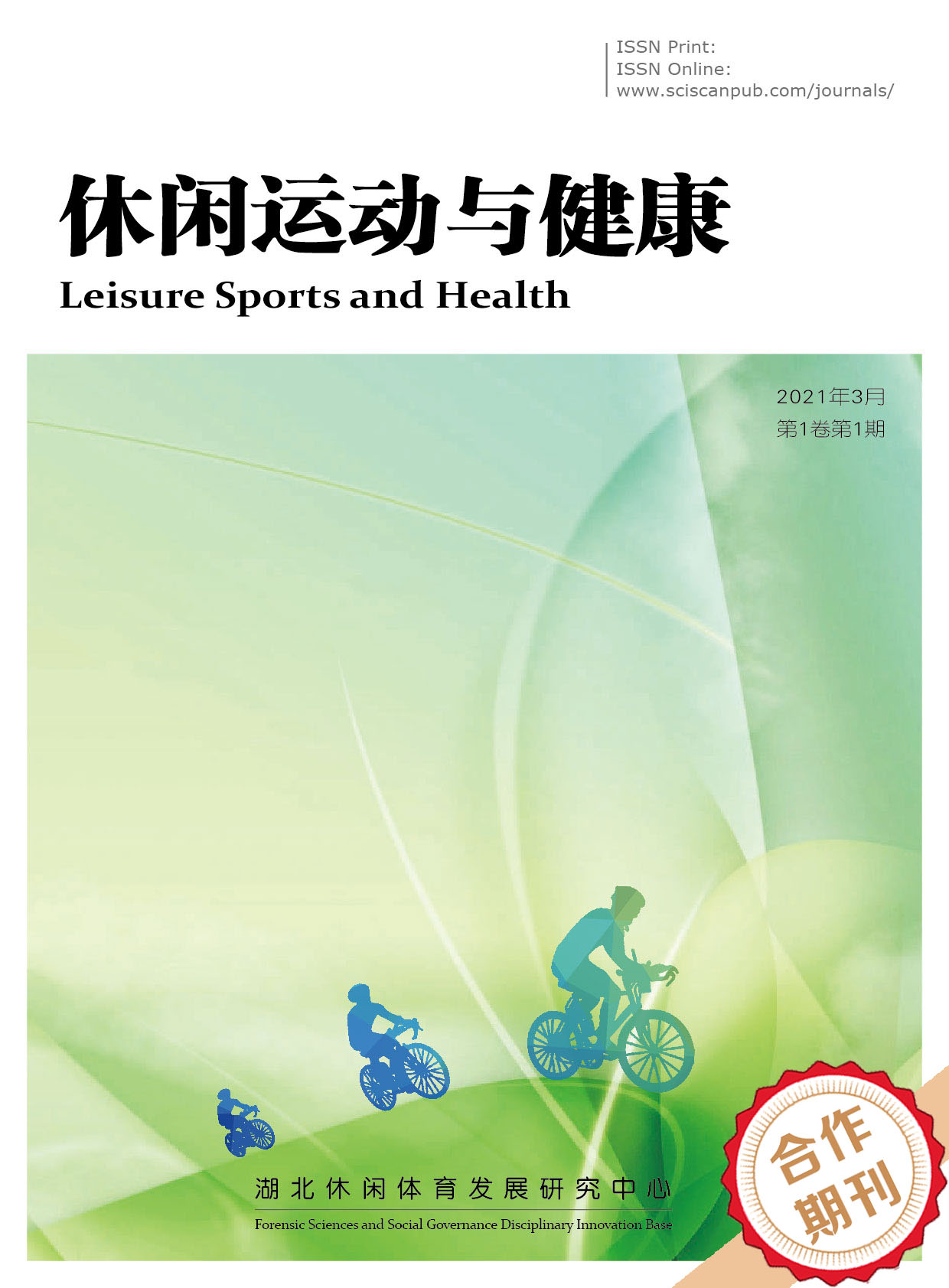Leisure Sports and Health
党的十八大以来我国青少年体质健康政策量化评价与实证研究
Quantitative Evaluation and Empirical Research on China’s Adolescent Physical Health Policies Since the 18th National Congress of the Communist Party of China
- Authors: 朱慧
-
Information:
湖北大学体育学院,武汉
-
Keywords:
Adolescent physical health policy; PMC index model; Quantitative evaluation青少年体质健康政策; PMC指数模型; 量化评价
- Abstract: The physical health of adolescents is an important cornerstone for building a healthy China and a strong sports nation. Using the PMC index model to quantitatively evaluate adolescent physical health policies, providing certain suggestions and references for the formulation and implementation of related policies. Selecting 12 sample policies since the 18th National Congress of the Communist Party of China as research objects, a PMC index model for adolescent physical health was constructed based on policy texts, which includes 9 primary variables and 36 secondary variables. Research has found that: (1) There are certain differences in policy scores in different periods, but the overall development trend is good; (2) The quality and status of adolescent physical health policies are gradually improving; (3) The content and structure of policy texts are gradually becoming more comprehensive, and the policy targets are becoming more diverse; (4) Policy formulation focuses on exploring diverse development paths and highquality development; (5) The policy text is relatively reasonable, but there is also some room for improvement. Meanwhile, using the PMC index model for quantification, it was found that: (1) Out of the 12 selected policies, 7 were rated as excellent and 5 were rated as good; (2) Among the 12 selected policies, the four primary variables of policy timeliness, policy nature, policy target, and policy evaluation have low ratings. Based on this, suggestions are proposed: (1) Promote the combination of diverse goals and stage goals; (2) Enhance the completeness of policy content; (3) Enriching the target audience of policies; (4) Establish a dynamic system for policy evaluation. 青少年体质健康是建设健康中国与体育强国的重要基石。借助PMC指数模型对青少年体质健康政策进行量化评价,为相关政策的制定与实施提供一定建议与参考。选取自党的十八大以来的12项样本政策作为研究对象,基于政策文本构建包含9个一级变量与36个二级变量的青少年体质健康PMC指数模型。研究发现:(1)不同时期的政策得分存在一定差异,但整体发展趋势良好;(2)青少年体质健康政策的质量与地位逐渐提高;(3)政策文本内容与结构逐渐丰满,政策对象呈现多元化;(4)政策制定注重探究多元发展路径与高质量发展;(5)政策文本较为合理,但也存在一定完善空间。同时,借助PMC指数模型量化发现:(1)所选12项政策中,7项评价为优秀,5项良好;(2)所选12项政策中,政策时效、政策性质、政策对象、政策评价这4个一级变量评分较低。基于此提出建议:(1)促进多元目标与阶段目标相结合;(2)增加政策内容完整度;(3)丰富政策的作用对象;(4)形成政策评价动态化体系。
- DOI: https://doi.org/10.35534/lsh.0403026
- Cite: 朱慧.党的十八大以来我国青少年体质健康政策量化评价与实证研究[J].休闲运动与健康,2024,4(3):156-166.
青少年是党和国家的未来,青少年的体质健康问题更是重中之重。习近平总书记强调学校教育要坚持健康第一的理念,将文化学习与体育锻炼协调发展,青少年通过体育锻炼促进体质健康水平、健全人格、锻炼意志的思想[1]。党的十八大以来,青少年体育发展迎来了强大动力,关于青少年健康发展等诸多方面被写入政策文件中[2]。为响应青少年体质健康需求,政府部门颁布了与体质健康相关的法例、条例、法律规范、意见、规划等规范性政策[3]。2016年,国务院针对青少年体质健康问题在《青少年“十三五”规划》中提到:增强青少年体质健康,建立完善的青少年体育公共服务体系,推动青少年体质健康的高质量、高效率可持续发展[4]。
青少年体质健康相关政策的颁布在一定程度上遏制了青少年体质健康下降的趋势,但是整体情况并未好转[5]。现有的研究表明,青少年体质健康问题一直未能得到妥善解决,这不仅和政策制定与调整的滞后性有关,还和政策执行过程未落实等有关[6]。而政策评价是政策施行效果的关键和重要保障,因此,亟需对青少年体质健康政策进行系统、科学的评价,发挥其及时调整与修正政策的作用,从而为我国青少年体质健康政策的补充完善提供系统科学的改进手段。为此,本文采用PMC模型,构建青少年体质健康政策的指数模型,对12项政策文本进行内容分析和量化评价,深入剖析出现的问题,提出切实可行的建议,旨在为政府及相关部门制定和完善青少年体质健康政策提供科学依据。
1 政策文本挖掘和指数模型构建
1.1 PMC指数模型
PMC指数模型的核心是构建一个具有丰富指标的评估体系。Ruiz Estrada提出了一部分比较具有代表性的一级变量来构建该评估体系,后续学者在运用该模型时,通常会根据所要评价的政策文本特点进行合理的添加、删除[7]。PMC指数模型作为政策文本量化评价的方法,通常以构建的多指标得分情况,衡量评价政策内部的一致性[8]。同时,该模型也能以三维可视化空间的方式,直观地展现政策的实际得分与优劣[9]。PMC指数模型的构建包括以下几个步骤,如图1所示。

图 1 PMC指数模型构建
1.2 政策筛选与确定
1)文本收集
在检索收集青少年体质健康政策的过程中,本文通过以下三种方式来进行交叉检索收集:(1)借助中国法律数字图书馆,以“青少年体质”“学生体质健康”“学校”“青少年”“学校体育”等为关键词进行检索;(2)借助“北大法宝”“中国法律资源库”网站平台以相同关键词进行检索;(3)借助国务院、国家体育总局等网站进行检索。
2)文本筛选标准
本文的筛选标准为:(1)根据发文主体,本研究仅选取党中央、国家体育总局等国家层面政策作为代表政策,各地方青少年体质健康政策不纳入研究范围;(2)根据发文内容,由于学校体育与促进青少年体质健康发展息息相关,所以本文将学校体育纳入研究,剔除发文内容为体育产业的文本以及函、会议通知等性质的政策文本。(3)根据发文时间,本文选取2012年-2024年4月14日(截取时间),按照以上标准搜集政策文本,共收集37项。
1.3 政策文本挖掘
本研究利用ROSTCM6.0软件工具进行文本挖掘。首先,将所收集的青少年体质健康政策文本导入到ROSTCM6.0软件工具中,进行分词处理和词频统计;然后,对词频结果进行加工处理,剔除与青少年体质健康政策无高度相关性以及没有任何作用的词汇,比如“非常”“特别”等副词;最后,提取词频数在前50的词汇作为政策关键词,并按照词频统计量由高到低进行排序,如表1所示。
表 1 青少年体质健康政策关键词词频统计结果
| 序号 | 词汇 | 词频 | 序号 | 词汇 | 词频 | |
| 1 | 体育 | 1947 | 26 | 促进 | 246 | |
| 2 | 健康 | 859 | 27 | 培训 | 245 | |
| 3 | 学生 | 616 | 28 | 部门 | 235 | |
| 4 | 发展 | 594 | 29 | 机制 | 232 | |
| 5 | 加强 | 524 | 30 | 国家 | 232 | |
| 6 | 建设 | 444 | 31 | 鼓励 | 229 | |
| 7 | 教育 | 414 | 32 | 教学 | 229 | |
| 8 | 开展 | 412 | 33 | 指导 | 224 | |
| 9 | 服务 | 404 | 34 | 积极 | 222 | |
| 10 | 运动 | 376 | 35 | 机构 | 217 | |
| 11 | 青少年 | 369 | 36 | 推动 | 209 | |
| 12 | 学校 | 364 | 37 | 儿童 | 209 | |
| 13 | 青少年体育 | 347 | 38 | 标准 | 204 | |
| 14 | 社会 | 339 | 39 | 科学 | 200 | |
| 15 | 管理 | 323 | 40 | 制度 | 187 | |
| 16 | 学校体育 | 310 | 41 | 体质健康 | 183 | |
| 17 | 组织 | 309 | 42 | 设施 | 179 | |
| 18 | 完善 | 306 | 43 | 全面 | 178 | |
| 19 | 水平 | 304 | 44 | 培养 | 178 | |
| 20 | 项目 | 300 | 45 | 改革 | 178 | |
| 21 | 提高 | 297 | 46 | 保障 | 175 | |
| 22 | 建立 | 283 | 47 | 落实 | 174 | |
| 23 | 卫生 | 265 | 48 | 推进 | 173 | |
| 24 | 健身 | 255 | 49 | 评价 | 164 | |
| 25 | 体系 | 247 | 50 | 训练 | 164 |
在关键词社会网络图中,每个方块的大小代表关键词的频数高低;该节点位置越居中,说明该节点在社会网络图中越重要;该节点度越大,即与该节点连接的边的数量越多,则该节点的度中心性越高;所处位置越居中,该节点在网络中就越重要[9]。本文通过R0STCM6.0软件工具,将所选择的政策文本导入该软件中,进行词频统计,过滤无作用词汇,最终构建主题词语义网络图,如图2所示。

图 2 主题词语义网络图
1.4 构建青少年体质健康PMC指数模型
1)变量选取及参数识别
基于高频词的统计情况,挖掘政策文本内容并结合参考相关文献,构建青少年体质健康政策—PMC指数政策评价模型。该模型基于Ruiz Estrada的政策评价标准研究,参照张永安、王进富等学者对变量选取的依据,初步拟定9个一级变量和40个二级变量,经过专家修改补充之后,最终设定9个一级变量指标与36个二级变量指标(如表2所示)。PMC指数模型的计算方法是通过二进制系统对二级变量指标进行赋值,若政策中包含相应变量,则赋值设定为1,若不包含,则赋值设定为0[10]。
表 2 体质健康政策PMC指数模型一、二级变量设置及依据
| 一级变量 | 二级变量 | 二级变量评分标准 | 参考依据 |
| X1政策时效 | X1:1短期 | 判断该项政策是否涉及短期规划(1~5年),是则为1,否则为0 | 张永安等[11] |
| X1:2中期 | 判断该项政策是否涉及中期规划(5~10年),是则为1,否则为0 | ||
| X1:3长期 | 判断该项政策是否涉及中期规划(>10年),是则为1,否则为0 | ||
| X2政策性质 | X2:1预测 | 判断该项政策是否具有预测性,是则为1,否则为0 | 周海炜等[12] |
| X2:2监管 | 判断该项政策是否涉及监管,是则为1,否则为0 | ||
| X2:3建议 | 判断该项政策是否涉及建议,是则为1,否则为0 | ||
| X2:4描述 | 判断该项政策是否具有描述性,是则为1,否则为0 | ||
| X2:5引导 | 判断该项政策是否具有引导性,是则为1,否则为0 | ||
| X2:6诊断 | 判断该项政策是否具有诊断性,是则为1,否则为0 | ||
| X3政策领域 | X3:1体育 | 判断该项政策是否涉及体育领域,是则为1,否则为0 | 社会网络图谱、文本分析、德尔菲法 |
| X3:2教育 | 判断该项政策是否涉及教育领域,是则为1,否则为0 | ||
| X4政策对象 | X4:1各级政府及直属机构 | 判断该项政策对象是否包括各级政府,是则为1,否则为0 | 词频分析、文本分析和德尔菲法 |
| X4:2学校 | 判断该项政策对象是否包括学校,是则为1,否则为0 | ||
| X4:3家庭 | 判断该项政策对象是否包括学校,是则为1,否则为0 | ||
| X4:4社会组织 | 判断该项政策对象是否包括社会组织,是则为1,否则为0 | ||
| X5政策重点 | X5:1体育锻炼 | 判断该项政策是否重视体育锻炼,是则为1,否则为0 | 词频分析、文本分析和德尔菲法 |
| X5:2学生体质健康 | 判断该项政策是否重视学生体质健康,是则为1,否则为0 | ||
| X5:3青少年体育 | 判断该项政策是否重视青少年体育,是则为1,否则为0 | ||
| X5:4学校体育 | 判断该项政策是否重视学校体育,是则为1,否则为0 | ||
| X6政策功能 | X6:1完善体系 | 判断该项政策是否包含完善体系功能,是则为1,否则为0 | 侍崇艳等[13]文章的修改、文本分析和德尔菲法 |
| X6:2健全设施 | 判断该项政策是否包含健全设施功能,是则为1,否则为0 | ||
| X6:3 改革机制 | 判断该项政策是否包含改革机制功能,是则为1,否则为0 | ||
| X6:4贯彻实施 | 判断该项政策是否包含贯彻实施功能,是则为1,否则为0 | ||
| X6:5开展活动 | 判断该项政策是否包含开展活动功能,是则为1,否则为0 | ||
| X6:6营造环境 | 判断该项政策是否包含营造环境功能,是则为1,否则为0 | ||
| X6:7其他 | 判断该项政策是否包含其他功能,是则为1,否则为0 | ||
| X7保障激励 | X7:1督导检查 | 判断该项政策是否具有督导检查,是则为1,否则为0 | 文本分析和词频分析 |
| X7:2评估考核 | 判断该项政策是否具有评估考核,是则为1,否则为0 | ||
| X7:3奖励问责 | 判断该项政策是否具有奖励问责,是则为1,否则为0 | ||
| X7:4组织领导 | 判断该项政策是否具有组织领导,是则为1,否则为0 | ||
| X7:5其他 | 判断该项政策是否具有其他保障激励,是则为1,否则为0 | ||
| X8政策评价 | X8:1依据充分 | 判断该项政策是否依据充分,是则为1,否则为0 | 张永安等[14] |
| X8:2目标明确 | 判断该项政策是否目标明确,是则为1,否则为0 | ||
| X8:3内容翔实 | 判断该项政策是否内容翔实,是则为1,否则为0 | ||
| X8:4权责清晰 | 判断该项政策是否权责清晰,是则为1,否则为0 | ||
| X8:5方案科学 | 判断该项政策是否方案科学,是则为1,否则为0 | ||
| X9政策公开 | 无 | 判断待评价政策是否公开, 有则为1,没有则为0 | Ruiz Estrada等[15] |
2)多投入产出表建立
多投入产出表是指通过存储大量数据来计算单独变量的一套数据分析框架[16]。多投入产出表由一级变量及二级变量构成,其中一级变量与二级变量没有固定的顺序,且变量间相互独立,二级变量权重相等[17]。
表 3 青少年体质健康政策多投入产出表
| 一级变量 | 二级变量 |
| X1 | X1:1;X1:2;X1:3 |
| X2 | X2:1;X2:2;X2:3;X2:4;X2:5;;X2:6 |
| X3 | X3:1;X3:2 |
| X4 | X4:1;X4:2;X4:3;X4:4 |
| X5 | X5:1;X5:2;X5:3;X5:4 |
| X6 | X6:1;X6:2;X6:3;X6:4;X6:5;X6:6;X6:7 |
| X7 | X7:1;X7:2;X7:3;X7:4;X7:5 |
| X8 | X8:1;X8:2;X8:3;X8:4;X8:5 |
| X9 |
3)PMC指数计算
①PMC指数计算过程分为以下四步:第一步,将构建的青少年体质健康政策PMC指数模型的一级变量和二级变量,构成多投入产出表;第二步,结合文本分析,按照公式(1)、公式(2)对二级变量进行二进制赋值;第三步,按照公式(3)计算一级变量的数值;第四步,按照公式(4)计算出青少年体质健康政策的PMC指数。
X~N[0,1] (1)
X={XR:[0,1]} (2)
 ,t=1,2,3,…,n (3)
,t=1,2,3,…,n (3)
其中,t为一级变量;j为二级变量
PMC= (4)
(4)
②根据公式(3)、(4)为二级变量赋值,计算各青少年体质健康政策对应的一级变量,并得出PMC指数值。
③根据公式(4)计算的每项青少年体质健康政策PMC指数值,参考陈彦丞[18]等的政策评价标准进行政策等级划分(如表4所示)。
表 4 政策评分等级
| 得分 | 9~10 | 7~8.99 | 5~6.99 | 3~4.99 | 0~2.99 |
| 评价 | 完美 | 优秀 | 良好 | 可接受 | 不良 |
④将获得的9个一级指标用于构建PMC曲面图,通过PMC曲面图的起伏状态,能够更直观地评价青少年体质健康政策的优劣部分。
PMC= (5)
(5)
2 青少年体质健康政策量化评价与实证研究
2.1 政策选取
首先,本研究以时间线为主要脉络,选取“十二五”时期的2项政策(P3、P4)、“十三五”时期的4项政策(P5~P8)、“十四五”时期的4项政策(P9~P10)。其次,根据第一轮专家访谈结果建议,为了确保不同阶段政策数量的平衡性与完整性,将P1、P2(于十八大之前颁布)补充至“十二五”时期相关政策。最后,第二轮专家认同对“十二五”时期的政策补充。最终选取了12项政策,如表5所示。
表 5 青少年体质健康政策文本
| 发布时期 | 序号 | 政策名称 | 发文字号 | 发布日期 | 发文机构 |
| “十二五”时期 | P1 | 教育部关于印发《切实保证中小学生每天一小时校园体育活动的规定》的通知[19] | 教体艺〔2011〕2号 | 2011年7月8日 | 教育部 |
| P2 | 体育总局关于印发《体育事业发展“十二五”规划》的通知[20] | 2011年04月01日 | 国家体育总局 | ||
| P3 | 国务院办公厅转发教育部等部门关于进一步加强学校体育工作若干意见的通知[21] | 国办发〔2012〕53号 | 2012年10月22日 | 国务院办公厅 | |
| P4 | 教育部关于印发《学生体质健康监测评价办法》等三个文件的通知[22] | 教体艺〔2014〕3号 | 2014年04月28日 | 教育部 | |
| P5 | 体育总局关于印发《青少年体育“十三五”规划》的通知[23] | 体青字〔2016〕92号 | 2016年09月08日 | 体育总局 | |
| P6 | 国务院办公厅关于强化学校体育促进学生身心健康全面发展的意见[24] | 国办发〔2016〕27号 | 2016年05月6日 | 国务院办公厅 | |
| “十三五”时期 | P7 | 体育总局 教育部关于印发深化体教融合 促进青少年健康发展意见的通知[25] | 体发〔2020〕1号 | 2020年08月31日 | 体育总局 教育部 |
| P8 | 中共中央办公厅、国务院办公厅印发《关于全面加强和改进新时代学校体育工作的意见》《关于全面加强和改进新时代学校美育工作的意见》[26] | 国办发〔2020〕30号 | 2020年10月15日 | 中共中央办公厅 国务院办公厅 | |
| P9 | 教育部办公厅关于进一步加强中小学生体质健康管理工作的通知[27] | 教体艺厅函〔2021〕16号 | 2021年04月19日 | 教育部办公厅 | |
| P10 | 教育部办公厅关于印发《〈体育与健康〉教学改革指导纲要(试行)》的通知[28] | 教体艺厅函〔2021〕28号 | 2021年06月30日 | 教育部办公厅 | |
| “十四五”时期 | P11 | 体育总局关于印发《“十四五”体育发展规划》的通知[29] | 体发〔2021〕2号 | 2021年10月08日 | 国家体育总局 |
| P12 | 教育部办公厅等十五部门关于印发《儿童青少年近视防控光明行动工作方案(2021—2025年)》的通知[30] | 教体艺厅函〔2021〕19号 | 2021年04月30日 | 教育部办公厅等十五部门 |
2.2 文本内容分析
对选取的青少年体育政策文本内容进行分析后发现:
第一,青少年体育受到重视。2012年颁布的P3《关于进一步加强学校体育工作若干意见的通知》重视青少年体质健康,认为其是全民健康素质的基本工程,学校需要进一步推动青少年健康成长。同年,P6《关于强化学校体育促进学生身心健康全面发展的意见》提到青少年体质健康的重要性,落实学校体育改革。2020年颁布的P7《关于深化体教融合 促进青少年健康发展的意见》则强调青少年体质健康与文化教育协调发展。2021年国家体育总局印发的P11《“十四五”体育发展规划》就青少年体质健康问题,专门提出相关优化建设的意见。以上政策的颁布表明青少年体育越发受到重视。
第二,青少年体育发展多元化。通过关键词(如图2所示)可知,“十二五”期间的政策文本中“青少年体育”与“学校体育”联系紧密。这说明学校对青少年体质健康起着关键作用,通过体育课提高身体素质,培养参与体育活动的习惯以及运动能力与技能。青少年体质健康政策在“十三五”到“十四五”时期逐渐呈现多元化发展趋势。以学校体育为基础,突出“青少年竞技体育”的作用,这与体育总局和教育部联合发布的P7《深化体教融合促进青少年健康发展意见》文件中所提到的“开展青少年竞技体育,培养体育后备人才”等内容相契合。这说明青少年体质健康通过学校体育和青少年竞技体育进行多元发展,是增进体质健康发展的主要途径。
第三,青少年体质健康政策文本逐渐丰满。通过三个时期的云图可以直观地看到:“十二五”时期主要围绕“体质健康”“发展”“管理”“评价”等词汇,文本以体质健康为首要目标,探究发展与管理方式以及政策实施效果的评价。“十三五”时期与“十四五”时期则着重突出“服务”“制度”“建设”“体系”“赛事”“机制”等关键词,说明在“十二五”完成学校青少年体质健康要求的基础上,完善政策制定体系、提高实施效果、增加赛事制定与主体、丰富评价机制与内容。其中,P5《青少年体育“十三五”规划》更是提出:政府主导、部门协同、全社会共同参与的青少年体育推动机制,这说明国家对青少年体育工作的重视以及政策文本的逐渐丰满。
第四,贯彻“以青少年身心全面发展为根本”的青少年体育高质量发展理念。从整体上看,十八大以来的青少年体质健康政策以身心健康为出发点,逐渐扩展到竞技体育、赛事项目、体育运动参与等方面,进一步丰富体质健康的内容与实现途径。在政策实施过程中强调“政府”“各部门”“社会”的重要性,将责任与义务下沉,构建出多元主体参与、管理的新型治理模式。围绕青少年身心全面健康发展这一核心,丰富政策内容与实现途径,贯彻青少年体育高质量发展。

图 3 “十二五”至“十四五”时期高频词云图
2.3 PMC 指数计算与曲面绘制
将赋值后的变量参数代入公式(3)和公式(4),计算12项政策的PMC 指数,并对政策所属等级进行划分,结果如表6所示。
表 6 青少年体质健康政策的PMC指数计算汇总
| X1 政策时效 | X2 政策性质 | X3 政策领域 | X4 政策对象 | X5 政策重点 | X6 政策功能 | X7 保障激励 | X8 政策评价 | X9 政策公开 | PMC指数 | 凹陷指数(S) | 排名 | 等级 | |
| P1 | 0.33 | 0.67 | 0.5 | 0.5 | 0.75 | 0.57 | 1 | 0.6 | 1 | 5.92 | 4.08 | 11 | 良好 |
| P2 | 0.33 | 1 | 0.5 | 0.75 | 0.5 | 0.86 | 1 | 0.8 | 1 | 6.74 | 3.82 | 10 | 良好 |
| P3 | 0.67 | 1 | 0.5 | 0.75 | 1 | 1 | 1 | 1 | 1 | 7.92 | 2.08 | 4 | 优秀 |
| P4 | 0.33 | 1 | 0.5 | 0.75 | 0.5 | 0.86 | 1 | 0.8 | 1 | 6.18 | 3.26 | 8 | 良好 |
| P5 | 0.33 | 1 | 0.5 | 1 | 1 | 1 | 0.71 | 1 | 1 | 7.54 | 2.46 | 6 | 良好 |
| P6 | 0.33 | 1 | 1 | 1 | 0.75 | 1 | 1 | 1 | 1 | 8.08 | 1.92 | 2 | 优秀 |
| P7 | 0.33 | 0.67 | 1 | 1 | 1 | 1 | 1 | 0.8 | 1 | 7.8 | 2.2 | 5 | 优秀 |
| P8 | 0.67 | 0.83 | 1 | 0.75 | 0.75 | 1 | 1 | 0.8 | 1 | 7.8 | 2.2 | 5 | 优秀 |
| P9 | 0.67 | 0.83 | 0.5 | 0.5 | 0.75 | 0.86 | 0.75 | 0.8 | 1 | 6.66 | 3.34 | 9 | 良好 |
| P10 | 0.33 | 0.67 | 1 | 0.75 | 0.75 | 0.86 | 0.75 | 0.8 | 1 | 6.91 | 3.09 | 7 | 良好 |
| P11 | 1 | 1 | 1 | 1 | 1 | 1 | 0.75 | 1 | 1 | 8.75 | 1.25 | 1 | 优秀 |
| P12 | 0.67 | 1 | 1 | 1 | 0.75 | 0.86 | 0.75 | 1 | 1 | 8.03 | 1.97 | 3 | 优秀 |
| 平均值 | 0.53 | 0.85 | 0.75 | 0.79 | 0.79 | 0.89 | 0.92 | 0.87 | 1 | 7.4 |
2.4 青少年体质健康政策的量化评价与实证分析
1)整体政策评价分析
从12项政策的PMC指数得分来看,评价为优秀的政策有7项,良好政策有5项。其中,P11的PMC得分最高,为8.75;P1的PMC指数得分最低,为5.92。按PMC得分进行排序为:P11(8.75)>P6(8.08)>P12(8.03)>P3(7.92)>P7(7.8)=P8(7.8)>P5(7.54)>P10(6.91)>P2(6.74)>P9(6.66)>P4(6.18)>P1(5.92)。这说明政策之间存在一定的差异,且整体差异幅度较大。优秀政策与良好政策得分的差异主要体现在政策性质、政策领域与政策对象等几个变量上,同时也反映出部分政策存在不足的核心原因。从12项政策的PMC整体得分来看,其均值为7.4,评价等级为优秀。大部分青少年体质健康政策的基本结构与内容较为完善,有效地促进了青少年体质健康水平的提高,这与已有研究结果和实际情况相一致。

图 4 青少年体质健康政策TM-PMC指数(数值)(的)簇状柱形图
2)“十二五”到“十四五”时期政策纵向对比分析
为了更好地展示政策发展过程中内容的变化,选取各时期固有的“体育事业发展规划”政策进行分析。通过原始数据发现,该政策在“十二五”时期、“十三五”时期与“十四五”时期的PMC得分依次为6.74、7.54、8.75,可以看出政策的PMC得分基本呈现上升的趋势,这也证实了政策内容与质量在逐渐提高,并且随着青少年体质健康政策的发展,政策的侧重点趋向多元化。2015年颁布的P6《关于强化学校体育促进学生身心健康全面发展的意见》是“体教融合,促健康发展”理念推广的“先手棋”;随后,2020年由官方文件直接提出“体教融合,促健康发展”理念;2020年P8《关于全面加强和改进新时代学校体育工作的意见》则是对“体教融合,促健康发展”理念的进一步深化;2023年中国智慧工程研究会体教融合工作委员会成立,标志着该理念的落地,并面向全社会征集体教融合(单项)试点示范基地。从青少年体质健康发展到体教融合,再到现阶段全社会共同参与,表明青少年体质健康正在高质量的发展。
3)各级变量横向对比分析
为了更好地探究所选政策整体与部分之间的关系,选取具有代表性的政策进行量化分析:将P11(8.75)、P7(7.8)、P1(5.92)的量化数据分别绘制曲面图。结合曲面图(如图5所示)与戴布拉图(如图6所示)对这3项青少年体质健康政策进行对比分析,探究政策之间的异同点。

图 5 政策样本P1、P7、P11的三维曲面图
通过绘制的曲面图可以直观地看到,P1的凹陷程度较大,P7相对较小,P11仅在一个位置出现塌陷。借助戴布拉图可以发现,三项政策仅有X9(政策公开)得分一致,其他变量均存在差异。其中,P7与P11存在差异的指标为X1(政策时效)、X2(政策性质)、X3(保障激励)与X8(政策评价)。差异较大的变量为X1(政策时效)、X3(政策领域)与X4(政策对象),差异较小的变量为X2(政策性质)、X5(政策重点)、X6(政策功能)、X7(保障激励)与X8(政策评价)。在变量中,仅有X7(保障激励)的得分是P1与P7高于P11,这说明P11得分虽最高,但政策部分内容也存在一定不足。至此,结合政策的实际得分情况以及各个指标的分布情况可以进一步进行分析。

图 6 青少年体质健康政策的戴布拉图
2.5 青少年体质健康政策的实证分析
1)政策时效性较为单一
在所选的12项样本政策中,仅有P11明确提出了短期、中期、长期三个阶段的发展目标,并注重政策执行的衔接程度。所选样本政策中的7项政策的X1(政策时效)得分低于平均值(0.53),说明政策多侧重于固定时期内的固定目标,缺少多元目标的结合,未充分重视政策目标多元化的重要作用。P6《教育部等部门关于进一步加强学校体育工作若干意见》提到:在“十二五”期末,学校体育设施达标,完善体质健康测量制度,形成学校体育评价机制。文本中仅涉及短期目标规划,容易影响政策实施的连贯性。长期目标规划虽明确规划了青少年体质健康政策的未来发展方向,强化了其在实施过程中的战略导向作用,但在一定程度上忽视了政策实施过程以及实施过程中的变化,难以及时做出调整以使政策达到预期实施效果。“十四五”时期政策目标的制定应满足以下要求:首先,不应局限于单一目标规划,要根据国家政策要求、青少年对美好体育的需求以及当前的青少年体质现状,建立长期、中期、短期相结合的政策目标;其次,应具体量化目标任务。例如,若想提高青少年体质健康水平,可在政策文本中明确规定青少年体育参与率、肥胖率、近视率、体质健康达标率等具体的目标期望结果[31],从而实现政策目标制定的精准性。
2)政策性质待完善
样本政策中6项政策的X2(政策性质)得分低于平均值(0.85),其中最低得分仅为0.5。该部分内容缺少对青少年体质健康问题现状的描述以及对政策实施结果的预测。在政策的制定过程中,现状是制定与实施的现实依据,是制定与实施的出发点。后续政策制定应更立足于现实问题,结合现状提出更具实用性与预见性的措施。其中,P7《体育总局、教育部关于印发深化体教融合 促进青少年健康发展意见》针对“预测”内容提及:通过有偿的形式招聘体校教练提供专项运动技能培训,教育部门加强对学校体育教学、课余训练、竞赛、体质健康监测的指导等。但对培训服务效果、学生满意程度以及报酬分配等方面并未进行说明,体质健康相关问题的监管责任主体、监管标准细则与方式也并未言明。首先,后续政策制定应对政策实施效果进行适当的延伸,以便在未达到预期效果时能及时发现短板,并采取补救措施。其次,应联合教育、体育、卫生等相关部门进行科学监管,将监管责任落实到位,明确政策扶持、专项资金、财政补贴等激励措施在实践过程中的监管主体、客体、范围与标准。最后,充分利用大数据等数字化技术,畅通监管渠道,将青少年体质健康的政策制定、实施、评价与反馈形成监管闭环,让青少年、家庭、社会力量等主体参与其中,及时获取对于青少年体育发展的监督意见并予以反馈。
3)政策作用对象不全面
所选的12项样本政策中有7项政策的X4指数值低于其变量均值,并且整体得分不高,说明政策对象覆盖不全。“十二五”时期的青少年体质健康政策的受众(对象)主要是政府部门和学校。在政策发展的过程中,逐渐由政府向社会力量购买体育服务,为青少年增强体质提供多样化的体育选择,且多次在政策文件中提到“将学校、社区与家庭作为青少年体育事业发展的主要推动力,促进青少年体质健康”。未来政策制定应适当拓展政策对象范围。在所选的样本政策中,P8《关于全面加强和改进新时代学校体育工作的意见》不仅强调学校、体校与社会体育俱乐部需要通过合作,共同开展体育教学、训练竞赛等内容。政策对象从家庭、学校与社区逐渐扩展到企事业单位工会、运动协会、基层体育社会组织等,尤其是青少年群体自身作为政策实施受体[32]。为此,要积极推动集中各群体的力量,为后续青少年体质健康政策的制定发挥最大的群体优势。吸取政策目标群体的意见,充分发扬政策制定的民主性,有利于增强目标群体的政策认同感,为有效化解后期政策执行过程中所遇到的利益诉求问题打下良好基础。
4)政策评价形式单一
整体来看,12项政策中有7项政策的X8指数值低于其变量均值。政策文本中仅提及“评价”,但并未言明“由谁评价”“评价的依据标准”以及“评价的方式”。评估机制的缺位,造成政策实施效果不明确。例如,在P1中提到“将学生参与校园活动的情况纳入学生综合素质评价体系”,但在实践过程中既没有关于参与校园活动的标准和活动评价细则,也尚未建立系统科学的评价指标体系和数据统计机制。
同样,在P9《教育部办公厅关于进一步加强中小学生体质健康管理工作的通知》中涉及评估青少年体质健康情况,将体质健康管理工作纳入地方教育行政部门和学校的评价考核体系,但未能在政策文本中体现评估依据的充分性和评估方式的多样化。应引入第三方专业机构等利益相关者来进行专业评价,通过现代科学体质检测手段的技术支撑,建立青少年体质健康评价清单,提升政策评价的专业度和可信度。同时,要制定科学合理的政策评估标准,设置相应的评估程序与方式,细化评估指标,提升政策评估的科学性与有效性[33]。最后,应对政策实施过程进行动态评估,构建完善的健康情况跟踪反馈机制,以便及时调整政策内容,为政策的进一步完善提供参考价值。
3 结论与建议
3.1 结论
本研究以青少年体质健康政策文本为研究对象,运用PMC指数模型、文本分析法与德尔菲法等方法,构建了由9个一级变量与37个二级变量组成的青少年体质健康政策PMC指数模型。借助建立的评价指标对选取的样本政策进行量化评价,得出PMC得分与曲面图。研究表明:(1)不同时期的政策得分存在一定差异,但整体发展趋势良好;(2)青少年体质健康政策的质量与地位逐渐提高;(3)政策文本内容与结构逐渐丰满,政策对象呈现多元化;(4)政策制定注重探究多元发展路径与高质量发展;(5)政策文本较为合理,但也存在一定的完善空间。
3.2 建议
前文对12项青少年体质健康政策从整体、不同时期以及具有代表性的政策进行了量化分析,发现青少年体质健康政策对青少年体质发展起到了重要的作用,产生了良好的效果。虽然青少年体质健康政策整体较为合理,但依旧存在进一步完善的空间。
第一,推动政策的多元目标与阶段目标相结合。青少年体质健康政策要推动体质健康水平的提高,需要以提高“体质健康”为主要目标,同时以不同时期不同阶段需要达到的要求作为次要阶段性目标。将多元目标与阶段目标相结合,发挥不同时期体质健康政策的作用,完成阶段性的目标,促进青少年体质健康的多元发展。
第二,完善政策性质。联合多部门共同协商青少年体质健康政策内容,发挥多部门优势,对政策性质提出预测性内容并对政策实施进行监管,提高政策制定的完整性以及政策实施过程监督的合理性。
第三,丰富政策作用对象。制定的政策需要通过政策对象实施才能产生效果,青少年体质健康应在政府与学校的基础上,向社会和企业下沉社会责任,让社会逐渐承担起促进青少年健康成长的责任。
第四,构建政策评价动态化体系。政策目标的单一性与实施过程的长远性使得政策实施效果评估较为困难。因此,在多元目标与阶段目标结合的基础上,形成适用的动态政策评价体系。多部门对政策实施效果进行评价,按照制定的阶段目标要求与实际完成程度进行对比,得出结论,对后续实施进行调整以完成政策目标。
参考文献
[1]中华人民共和国中央人民政府.习近平主持召开教育文化卫生体育领域专家代表座谈会并发表重要讲话[EB/OL].(2020-09-22)[2024-03-19].https://www.gov.cn/xinwen/2020-09/22/content_5546100.htm.
[2]李冲,史曙生.我国青少年体质健康促进政策评估现存问题及改进思路[J].体育学刊,2018,25(4):68-72.
[3]郇昌店.基于HiAP框架论青少年体质健康政策体系[J].山东体育学院学报,2016,32(1):5-11.
[4]国家体育总局.关于印发《青少年体育“十三五”规划》的通知[EB/OL].(2016-09-08)[2024-03-20].https://www.sport.gov.cn/n10503/c750118/content.html.
[5]李东斌.青少年体质健康促进政策研究[J].体育文化导刊,2014(12):13-15,30.
[6]秦婕.基于政策视角下的青少年体质健康促进研究[J].西安体育学院学报,2015,32(1):71-74.
[7]刘戎,吴秋昊.“十三五”期间节水政策的量化评价——基于PMC指数模型[J].资源与产业,2023,25(1):40-50.
[8]Ruiz Estrada M A,Park D.The past,present and future of policy modeling [J].Journal of Policy Modeling,2018,40(1):1-15.
[9]宋大成,焦凤枝,范升.我国科学数据开放共享政策量化评价——基于PMC指数模型的分析[J].情报杂志,2021,40(8):119-126.
[10]程美超,王舜.我国体育产业政策的量化评价——基于PMC指数模型[J].天津体育学院报,2021,36(5):590-593,620.
[11]张永安,周怡园.新能源汽车补贴政策工具挖掘及量化评价[J].中国人口·资源与环境,2017,27(10):188-197.
[12]周海炜,陈青青.大数据发展政策的量化评价及优化路径探究——基于PMC指数模型[J].管理现代化,2020,40(4):74-78.
[13]侍崇艳,韩萍萍,张美玲,等.基于PMC指数模型的青少年体质健康促进政策量化评价与实证研究[J].体育与科学,2022,43(6):73-85.
[14]张永安,郄海拓.国务院创新政策量化评价——基于 PMC指数模型[J].科技进步与对策,2017,34(17):127-136.
[15]Estrada M R,Yap S F,Nagaraj S.Beyond the Ceteris Paribus Assumption:Modeling Demand and Supply Assuming Omnia Mobilis[J].Social Science Electronic Publishing,2007.
[16]Estrada M A R.Policy Modeling Definition,Classification and Evaluation[J].Journal of Policy Modeling,2011,33(4):523-536.
[17]蔡冬松,柴艺琳,田志雄.基于PMC指数模型的吉林省数字经济政策文本量化评价[J].情报科学,2021,364(12):139-145.
[18]陈彦丞.基于PMC指数模型的社区减负政策量化评价与优化研究[J].山东农业大学学报(社会科学版),2022,24(2):45-53.
[19]教育部.关于印发《切实保证中小学生每天一小时校园体育活动的规定》的通知[EB/OL].(2011-07-08)[2024-03-19].http://www.moe.gov.cn/srcsite/A17/s7059/201107/t20110708_171747.html.
[20]国家体育总局.关于印发《体育事业发展“十二五”规划》的通知[EB/OL].(2011-04-01)[2024-03-20].https://www.sport.gov.cn/n4/n123/c209240/content.html.
[21]国务院办公厅.转发教育部等部门关于进一步加强学校体育工作若干意见的通知[EB/OL].(2012-10-22)[2024-03-19].https://www.gov.cn/zwgk/2012-10/29/content_2252887.htm.
[22]教育部.关于印发《学生体质健康监测评价办法》等三个文件的通知[EB/OL].(2014-04-28)[2024-03-20].http://www.moe.gov.cn/srcsite/A17/s7059/201404/t20140428_168528.html.
[23]国务院办公厅.关于强化学校体育促进学生身心健康全面发展的意见[EB/OL].(2016-05-06)[2024-03-20].https://www.gov.cn/zhengce/content/2016-05/06/content_5070778.htm.
[24]国家体育总局 教育部.关于印发深化体教融合 促进青少年健康发展意见的通知[EB/OL].(2020-08-31)[2024-03-20].https://www.gov.cn/zhengce/zhengceku/2020-09/21/content_5545112.htm.
[25]中共中央办公厅 国务院办公厅.印发《关于全面加强和改进新时代学校体育工作的意见》《关于全面加强和改进新时代学校美育工作的意见》[EB/OL].(2020-10-15)[2024-03-20].https://www.gov.cn/gongbao/content/2020/content_5554511.htm.
[26]教育部办公厅.关于进一步加强中小学生体质健康管理工作的通知[EB/OL].(2021-04-19)[2024-03-20].https://www.gov.cn/zhengce/zhengceku/2021-04/26/content_5602164.htm.
[27]教育部办公厅.关于印发《〈体育与健康〉教学改革指导纲要(试行)》的通知[EB/OL].(2021-06-30)[2024-03-20].http://www.moe.gov.cn/srcsite/A17/moe_938/s3273/202107/t20210721_545885.html.
[28]体育总局.关于印发《“十四五”体育发展规划》的通知[EB/OL].(2021-10-08)[2024-03-20].https://www.gov.cn/zhengce/zhengceku/2021-10/26/content_5644891.htm.
[29]教育部办公厅等十五部门.关于印发《儿童青少年近视防控光明行动工作方案(2021—2025年)》的通知[EB/OL].(2021-10-08)[2021-04-30].http://www.moe.gov.cn/srcsite/A17/moe_943/s3285/202105/t20210511_530655.html.
[30]陈作松,汪流,史文文,等.我国青少年体育高质量发展研究[J].首都体育学院学报,2023,35(5):503-511.
[31]吴金霖,刘红建.澳大利亚青少年体育政策演变历程、经验与启示[J].体育文化导刊,2024(2):102-110.
[32]Department of Health.Strategy Policy Planning.The Best Opportunities in Life:Northern Territory Child and Adolescent health and Wellbeing Strategic Plan 2018-2028 [R].Department of Health,2022.
[33]陈军,张韵君.政策工具视角下我国高等教育产教融合政策分析[J].黑龙江高教研究,2023,41(3):64-71.
















